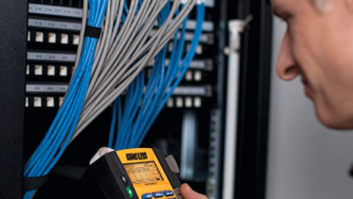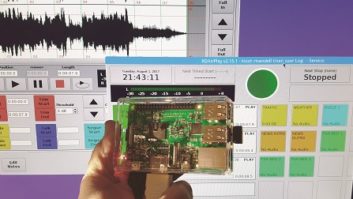When it comes to hardware that is subject to abuses of “guests” and others, none is under duress more than microphones and headsets. Here’s an area crying out for a cost-effective solution for reliability, guest comfort, ease of use, security/theft control and hygiene.

With the advent of computers, and more specifically the microphone audio interface, an interesting solution has appeared: the computer headset microphone. These units, predominantly imported, are reminiscent of event location headset mics used in sports reporting, although lighter in gauge and less sophisticated. Light on the head and with a reasonably good sounding mic, they remind us of the benefits of mass production. Costing under $10, sometimes as cheap as $7 in bulk, they are available from sources as convenient as RadioShack (at a price premium) and from many national computer discounters. You can even order in case lots.
The only bug-a-boo? Normally you need an interface to provide the operating voltage for the unit’s electret mic, and electronically make the conversion from essentially high-impedance unbalanced to a nominal 150 ohm balanced output, to mimic a regular microphone for station use.
Let’s design and build that interface. We’ll include desirable extra features such as an individually operated headset level control and simple processing to enhance voice band audio response for increased intelligibility.
I’ve tried over the years to offer ideas for simple yet valuable gear for your station that can be expensed from petty cash and built on a time-available basis. Call this another such “therapy” project.

Details
Mics in these units are DC powered and the computer typically supplies 5 volts (unloaded). The tiny load that is the mic’s FET amplifier drops the voltage to about 2.5 volts, and the voltage variation around this axis point is the actual audio from the mic. Most computers use an internal series resistor of about 10 k-ohms; that’s what we’ve used as well.

The design of our “box” is centered on an input power supply of a single DC voltage, nominally between 7 and 15 volts. A 12-volt DC 100 mA wallwart, bought or liberated from your junk box, will work. In a rare situation where the mic is away from all hard power, a good 9 V DC battery will supply power to the box for between 5 and 10 hours of continuous use with a 45 mA or so drain; think Duracell or Energizer 9 volt.
This voltage enters the box through a side connector and immediately is dropped to a regulated 5 volts via a 7805 three-pin regulator. At this point 5 volts is supplied to the mic through that 10 k, 1/2-watt resistor.
The ripple on this 5 volts is low, 3 to 5 mV, which is necessary for a mic of this type.
That regulated 5 volts also is fed to a DC-to-DC converter to develop the 12 volts + and – for the op amps.
One 1458 (essentially a pair of compensated 741s in a single eight-pin DIP) is used as a pair of cascaded filters to shape the audio into the voice band. The other is used as a unity gain cascaded pair to provide a pair of separate outputs, one plus and one minus polarity. These voltages, from essentially near zero impedance generators, pass through a 68 ohm resistor in each leg, creating a balanced source impedance of 136 ohms, which is close enough to 150 ohms for our matching purposes.
A DPDT switch selects mic audio with or without processing.
Audio for the headset could come from a multiplicity of sources but we expected the program audio to come at speaker level. The audio enters the box in a 1/4-inch mono chassis mount jack. To quiet the audio in the headsets fully, we’ve chosen a single circuit jack with a normally closed contact on it. When nothing is plugged in, the headset line shorts to ground.
The headset audio passes to the on/off switch on a 1 k audio tapered pot. When you turn “on” the pot, the audio is connected to the top of the pot. The bottom (ground end) of that pot is connected to a 100-ohm resistor that goes to ground. This prevents the audio from being turned off completely unless you turn off the audio with the switch.

People are people and do strange things. I had a guest turn down her audio and then suddenly go ballistic when she couldn’t hear anything. This little bit of audio at the end is helpful in always keeping some audio on.
This interface unit for a single mic was hand-assembled on DIP proto-boards. You can use just about any scheme you want for wiring and assembly. If your talent work in pairs, it might be prudent to build two mic channels into the same box. The DC-DC converter specified should just be able to handle four op-amps.
Early field use has complained that some RF from RPUs or nearby transmitters is getting into the mic appearing as a low sizzle sound. A 0.01 uf ceramic disc capacitor across the mic “high” input to ground eliminates most of this. Several of the various mic/headsets that we’ve been using have little shielding in the mic cord; this appears to be the most likely entry point. You may find that some brands of mic headsets have less propensity for this (probably more shielding); make these units your first choice.
Now when you have guests in studio or on location, you can make them feel special by taking a new, spiffy clean mic headset for them out of the box. You can even let them take it home as a useful souvenir of their appearing on the radio with you when done. At the least, you’ve taken a “wear item” and made its maintenance a disposable issue.
Charles S. Fitch, W2IPI, is a registered professional consultant engineer, member of the AFCCE, senior member of the SBE, lifetime CPBE with AMD, licensed electrical contractor, former station owner and former director of engineering of WTIC(TV) in Hartford, Conn., and WHSH(TV) in Boston.









